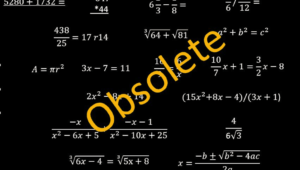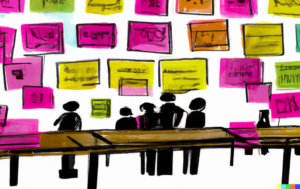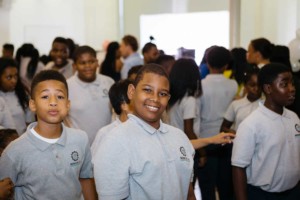What is Conceptual Understanding?

By Tatum Moser and Vivian Chen
In his keynote speech at ISTE 2016, Michio Kaku explained that educational development and teaching methods often follow breakthroughs and waves of technology. As new waves of technology emerge, teaching and learning expand throughout grade levels in breadth and depth to match the wave’s necessity for skills.
As the fourth wave of technology—the quantum era—nears, Kaku calls for a revolution in education: the way that students are taught must change. How then can we teach to prepare future generations for careers and life in a technologically-advanced world?
We agree with Kaku that the key is to shift the focus and teach for conceptual understanding.
Conceptual Understanding Defined
Conceptual understanding, where children can grasp ideas in a transferrable way, can help students take what they learn in class and apply it across domains. It’s a hot topic in the classroom today, as rote memorization and traditional methods of teaching math are becoming considered insufficient for real-world learning and application.
While teaching to the test is common for state accountability and measurement, these methods don’t always arm students with the skills to complete tasks outside of the classroom.
In a study conducted by Brown and Kane, preschool children were likely to transfer skills across different situations when they were encouraged to use prior taught and shown solutions. They learned best when they saw examples of solutions rather than being given an explicit rule.
In this vein, when carried over to math or another academic subject, children should be able to make decisions based on an emerging understanding gained by witnessing example solutions, not an explicit rule that only covers one problem or one way of answering a problem.
Career Readiness
When people perform in a workplace, they often act based on previous knowledge, assumptions and understandings they have about a particular situation. They intelligently make decisions on what to do, and this often has to be done in an exploratory, innovative way, especially if it’s a novel situation. More often than not, people won’t have all the necessary information they need to explicitly be told how to make the correct decision. This is where developing conceptual understanding and associations comes in.
If students aren’t given the chance to experience this type of exploratory learning as young learners, they will lack the appropriate skills to develop situations to everyday problems. We can teach our students all the information they need, but if they’re not building on, analyzing, evaluating or having the chance to be creative with this knowledge in a relevant way and making associations, they won’t develop the ability to deeply understand and transfer knowledge to make educated assumptions about new situations.
When information isn’t available, people need to use the conceptual understandings and associations they’ve formed about similar concepts to successfully execute decisions. As Kaku foreshadowed, the fourth wave of technology is coming and is entirely new, so we must prepare our students to be able to make decisions and use deeper understanding to process new information.
So how do we get there?
How Conceptual Understanding is Achieved
Combining academic learning, assessment and soft skills doesn’t have to be difficult. As Kaku noted in his keynote speech, information can be taught in various ways, from MOOCs and robots, to the Internet, people and more. Robots can replace the way information is taught or how basic tasks are performed, but creativity, experience and underlying structures may not be as replaceable.
What needs to be taught that hasn’t been an emphasis in previous decades is the common thread throughout concepts, the underlying structure of information and how ideas are related. To achieve this, we have to take our students through real world examples of professions and embed the learning within.
Just as an effective learning game has the learning tied into the core mechanics of the game, effective teaching activities need to incorporate real strategies that students will use in the real world. Instead of purely teaching memorization and facts, we have to prepare people to take abstract ideas to form thoughtful opinions and decisions as they would in a future profession.
One way to get people to understand something is to take what they’re interested in and have them explore it as if they were in that field. Especially in a school district that might not have the resources to pursue personalized learning, project-based learning and exploratory units are excellent ways to approach conceptual understanding.
In social studies, for example, rather than giving your students facts and dates, ask them to approach history as an anthropologist — have them read books as a historian who wants to understand why an event happened, and identify people groups and traditions and customs as an anthropologist. When students can piece these ideas together, they’re developing the skills to see underlying patterns and cause and effect.
As author Warren Berger discovered, children love having questions answered, and this lights a fire inside of them to want to know more. In the classroom, we can address this by encouraging curiosity. In a science unit, have your students explore a hypothesis as a scientist. Ask them how scientists approach new ideas — do they test them? What do they research? What do they need to know? Beyond knowing about cells and what they do, have them develop an understanding about how cells work. Making these connections early on will equip them with the critical thinking and investigative tools necessary to make informed assumptions.
When they ask great questions, they generate curiosity and more questions. As they ask more questions, they understand more deeply. We have to present students with situations with common threads so they can begin to learn patterns and underlying structures by asking questions themselves.
Promoting Equity Through Conceptual Understanding
While information and facts are crucial to a student’s success, what’s more important—but often underdeveloped because testing does not typically assess this—is the ability to find connections. Standardized testing has traditionally measured a student’s ability to memorize information and quickly plug in formulas, and when students are unable to perform that way, they’re placed lower than others and given special attention. In an actual workplace setting though, this memorization of skills and the specific score a student receives may not be indicative of his ability to perform or utilize prior knowledge to make an informed decision.
When we teach for understanding and not memorization, we’re leveling the playing field and equipping students with the skills to succeed in the future. The ability to transfer skills and knowledge will be much more advantageous than information that might become irrelevant, and making this the primary focus will relieve the burden on students to try to memorize information separate from how it can be utilized in a project or real world setting.
Biotechnology, nanotechnology and artificial intelligence may be new concepts, but there could be underlying patterns and existing ideas that can be applied to the ways we approach new developments. By teaching for exploratory, conceptual understanding, we are teaching students to find patterns and think like real world professionals. When we do this, we are equipping students with the skills to succeed beyond a standardized test and tackle the fourth wave head-on.
For more, see:
- Conceptual Instruction And Middle Grades Math Blends: An Interview With Content & Instruction Expert Shara Turner
- Making Math 3D
- Framing the Learning in the Blended Learning Environment
Vivian Chen is a Learning Designer at Education.com. Follow them on Twitter: @Education_com.
Stay in-the-know with all things EdTech and innovations in learning by signing up to receive the weekly Smart Update.






0 Comments
Leave a Comment
Your email address will not be published. All fields are required.